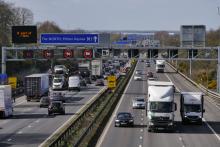The British Government policy paper ‘Action for Roads: A network for the 21st century’ sets out radical change to the strategic way roads are funded and managed – including plans to turn the Highways Agency into a Government-owned company and a pledge to invest over €33.4 billion (£28 billion) in roads maintenance between 2015 and 2020. Jenny Moten, Highways Agency divisional director for Network Services, gave a keynote presentation on the new approach to strategic highways management during the Road Safet
The British Government policy paper ‘Action for Roads: A network for the 21st century’ sets out radical change to the strategic way roads are funded and managed – including plans to turn the Highways Agency into a Government-owned company and a pledge to invest over €33.4 billion (£28 billion) in roads maintenance between 2015 and 2020. Jenny Moten, Highways Agency divisional director for Network Services, gave a keynote presentation on the new approach to strategic highways management during the 5149 Road Safety Markings Association (RSMA) annual conference. Guy Woodford heard what she had to say
Employing around 3,500 people, the current2309 Highways Agency (HA) is an executive agency for the 5432 Department for Transport and is responsible for operating, maintaining and improving the €118.14 billion (£99 billion), 6,920km (4,300mi) Strategic Road Network (SRN) in England. Significantly, while the SRN makes up just 2% of England’s roads by length, it covers a third of all traffic. Furthermore, two-thirds of heavy goods vehicle (HGV) driving is undertaken on the SRN. It is, as Jenny Moten described in her recent RSMA conference speech, the “economic backbone of the country”.
So just how will, in the HA’s own words, “radically changing” the funding and managing of the SRN improve safety and journey reliability for its average user motorist?
“A good transport system should be to the advantage of the United Kingdom; however, past investment has threatened to turn this into a weakness,” said Moten, adding, “In recent decades we have been falling behind other countries. While the UK’s spending on roads slowed in the 90s and beyond, our competitors have continued to invest. Between 2000 and 2009 only 46 miles (74.02km) of new motorway were opened in the UK. Over the same period, France opened up over 850 miles (1,367km) of new network. We have a lot to do to catch up.”
Moten outlined how, in response to the lack of highways investment, the government was embarking on its “biggest ever” upgrade of existing roads, including 52 national road projects - including €1.79 billion (£1.5 billion) of work to relieve congestion on the A14 in Cambridgeshire, and upgrades on the A19, A21 and A27; 120 pinch point (junction, slip road) schemes; a €7.16 billion (£6 billion) investment in maintenance; and the resurfacing of 80% of the SRN. In addition, 355.6kms (221 miles) of extra SRN capacity will be created by opening up the hard shoulder using managed motorways technology.
While these changes, said Moten, were “good news for road users and industry”, the increased investment “doesn’t guarantee us a world class network”. Focusing on the new Government-owned company set to manage England’s SRN from April 2015, which the HA estimate will save taxpayers at least €3.1 billion (£2.6 billion) over the next decade, she added, “The recommendation from ‘Action for Roads’ was to transform the way the Agency is run by turning it into a publicly-owned strategic highways company, to give it greater day-to-day independence, and to drive more commercial decision-making. Progress has been made and we are moving at pace.”
Moten highlighted how a Road Investment Strategy (RIS) for the new Government-owned company will include a long-term strategy, setting out the vision for the SRN; clear performance targets for what the new company must deliver; an investment plan specifying the schemes and areas where money will be spent; and a statement of funds available that the government is committing to provide. The first RIS will be in place by the end of 2014 and run until 2021.
It is not enough, said Moten, to manage the relationship between the government and the new SRN management company; the relationship had to be “more transparent”, with better ways needed to represent the views of road users in decision-making.
“In other sectors such as railways, independent regulators are responsible for holding companies to account and representing the interests of the customers. However, for the road network this approach would not generate sufficient benefits to justify the additional bureaucracy, something that we’re probably all pleased to hear,” said Moten, who explained that, as an alternative, two core scrutiny functions would be used as part of the new Government-owned SRN company set-up. “A user watchdog will provide a single, credible and independent focal point for gathering and balancing the views of all users, making use of national surveys to provide feedback as to how well the company is performing. And an efficiency monitor will provide a third-party assessment of how the company is performing against the Road Investment Strategy, and provide independent advice to the Secretary of State and to benchmark performance on cost and efficiency against domestic and international comparators.”
Speaking empathetically to Road Marking 2013 conference delegates, Moten added, “We recognise that how the [Highways] Agency operates today can have a negative impact on your business. Annualised funding and the stop-go culture that it drives mean that you can only plan your business from one year to the next, with short and frequently changing notice of when your services are required. It means you suffer from the ‘hockey stick’ effect: when a lot of activity is programmed for the last quarter of the year. It’s a period when working daylight hours are short, when the UK tends to suffer its most severe weather and temperatures drop making working conditions difficult, when there is a huge pressure to get schemes on the ground in a tight timeframe, running the risk that our focus is distracted from ensuring the safety of our roadworkers. It means you are stretched to capacity for only a percentage of the year, limiting your business development in that period, while at other times of the year you are working u
nder capacity, with spare resources representing a cost on your bottom line. This culture exposes the supply chain to the risk of uncertainty.”
As an illustration of the present working relationship between the HA and its supply chain, Moten said one engineering firm reported that when two major highway schemes were cancelled 50 of the 70 staff working on it had to be made redundant, at a cost to the company of €596,000 (£500,000). She said it was clear that this scenario was “not sustainable for any business”.
She continued, “The benefits to the industry of a change in how the Agency operates are real and direct. Clear long-term funding settlements, without the risk of fluctuation, will give you the opportunity to better plan your needs in terms of equipment and resources. It will enable you to think strategically about how you can get the best return from the market as a whole, rather than tactically preparing for each individual project. It will also support your decision to invest in skills, plant and equipment over the longer term, rather than hiring these resources at short-term prices.
“With an investment of this size, it’s not a matter of doing what we already do in the same way. We need to innovate to find new ways of doing things, if we are to safely, efficiently and effectively deliver this programme. Collaboration between the Agency and its supply chain will be necessary. Collaboration across each category within the supply chain will be vital.”
Moten stressed that the safety of road users would also remain a priority, working with partners such as roads policing teams on not just “physical interventions”, but also ways to improve and influence road user behaviour.
She highlighted police Killed of Serious Injury (KSI) statistics for the SRN in 2012. During the year, 217 people were killed and 1,479 seriously injured following 10,520 road traffic collisions involving 22,437 vehicles. The 16,673 overall casualties from these collisions made up 8.5% of all reported road casualties in Great Britain. Quoting other figures, Moten said nine roadworkers and construction workers died on the SRN between 2007 and 2009.
“These figures, while they are the lowest number we’ve been able to report to date, still show that there is much more that needs to be done to reduce the impact and cost of human injuries.
“We have seen continued year on year growth in vehicle traffic, and while the investment in our network is increasing, we must ensure that the number of people killed and injured on a network does not.”
Cash shortfall behind “dangerous” UK road markings
During a Q&A session following Jenny Moten’s speech at the RSMA conference at Eastwood Hall in Nottingham in late 2013, an Association member said the RSMA’s most recent survey of the Highways Agency (HA) Strategic Road Network road markings found that the majority of markings fell below HA minimum standard, with 20% falling in the “dangerous” category.
Asked how the HA had allowed road markings to deteriorate “substantially”, and whether anything was going to be done about it, Moten replied, “It all comes down to funding. From personal experience, my role in the Agency over the past few years was to get that funding to make those improvements to the road network and to deliver them. It has been really, really difficult in the last few years to get funding, full stop.
“One of the things we have realised is the value for money process that we go through to identify the priority schemes doesn’t do enough to support the type of schemes that you in the room want to deliver.”
Praising work done by others to rectify this, she added, “The mechanism is now in place to ensure that funding and prioritisation of those schemes is an easier thing to do.”
Employing around 3,500 people, the current
So just how will, in the HA’s own words, “radically changing” the funding and managing of the SRN improve safety and journey reliability for its average user motorist?
“A good transport system should be to the advantage of the United Kingdom; however, past investment has threatened to turn this into a weakness,” said Moten, adding, “In recent decades we have been falling behind other countries. While the UK’s spending on roads slowed in the 90s and beyond, our competitors have continued to invest. Between 2000 and 2009 only 46 miles (74.02km) of new motorway were opened in the UK. Over the same period, France opened up over 850 miles (1,367km) of new network. We have a lot to do to catch up.”
Moten outlined how, in response to the lack of highways investment, the government was embarking on its “biggest ever” upgrade of existing roads, including 52 national road projects - including €1.79 billion (£1.5 billion) of work to relieve congestion on the A14 in Cambridgeshire, and upgrades on the A19, A21 and A27; 120 pinch point (junction, slip road) schemes; a €7.16 billion (£6 billion) investment in maintenance; and the resurfacing of 80% of the SRN. In addition, 355.6kms (221 miles) of extra SRN capacity will be created by opening up the hard shoulder using managed motorways technology.
While these changes, said Moten, were “good news for road users and industry”, the increased investment “doesn’t guarantee us a world class network”. Focusing on the new Government-owned company set to manage England’s SRN from April 2015, which the HA estimate will save taxpayers at least €3.1 billion (£2.6 billion) over the next decade, she added, “The recommendation from ‘Action for Roads’ was to transform the way the Agency is run by turning it into a publicly-owned strategic highways company, to give it greater day-to-day independence, and to drive more commercial decision-making. Progress has been made and we are moving at pace.”
Moten highlighted how a Road Investment Strategy (RIS) for the new Government-owned company will include a long-term strategy, setting out the vision for the SRN; clear performance targets for what the new company must deliver; an investment plan specifying the schemes and areas where money will be spent; and a statement of funds available that the government is committing to provide. The first RIS will be in place by the end of 2014 and run until 2021.
It is not enough, said Moten, to manage the relationship between the government and the new SRN management company; the relationship had to be “more transparent”, with better ways needed to represent the views of road users in decision-making.
“In other sectors such as railways, independent regulators are responsible for holding companies to account and representing the interests of the customers. However, for the road network this approach would not generate sufficient benefits to justify the additional bureaucracy, something that we’re probably all pleased to hear,” said Moten, who explained that, as an alternative, two core scrutiny functions would be used as part of the new Government-owned SRN company set-up. “A user watchdog will provide a single, credible and independent focal point for gathering and balancing the views of all users, making use of national surveys to provide feedback as to how well the company is performing. And an efficiency monitor will provide a third-party assessment of how the company is performing against the Road Investment Strategy, and provide independent advice to the Secretary of State and to benchmark performance on cost and efficiency against domestic and international comparators.”
Speaking empathetically to Road Marking 2013 conference delegates, Moten added, “We recognise that how the [Highways] Agency operates today can have a negative impact on your business. Annualised funding and the stop-go culture that it drives mean that you can only plan your business from one year to the next, with short and frequently changing notice of when your services are required. It means you suffer from the ‘hockey stick’ effect: when a lot of activity is programmed for the last quarter of the year. It’s a period when working daylight hours are short, when the UK tends to suffer its most severe weather and temperatures drop making working conditions difficult, when there is a huge pressure to get schemes on the ground in a tight timeframe, running the risk that our focus is distracted from ensuring the safety of our roadworkers. It means you are stretched to capacity for only a percentage of the year, limiting your business development in that period, while at other times of the year you are working u
nder capacity, with spare resources representing a cost on your bottom line. This culture exposes the supply chain to the risk of uncertainty.”
As an illustration of the present working relationship between the HA and its supply chain, Moten said one engineering firm reported that when two major highway schemes were cancelled 50 of the 70 staff working on it had to be made redundant, at a cost to the company of €596,000 (£500,000). She said it was clear that this scenario was “not sustainable for any business”.
She continued, “The benefits to the industry of a change in how the Agency operates are real and direct. Clear long-term funding settlements, without the risk of fluctuation, will give you the opportunity to better plan your needs in terms of equipment and resources. It will enable you to think strategically about how you can get the best return from the market as a whole, rather than tactically preparing for each individual project. It will also support your decision to invest in skills, plant and equipment over the longer term, rather than hiring these resources at short-term prices.
“With an investment of this size, it’s not a matter of doing what we already do in the same way. We need to innovate to find new ways of doing things, if we are to safely, efficiently and effectively deliver this programme. Collaboration between the Agency and its supply chain will be necessary. Collaboration across each category within the supply chain will be vital.”
Moten stressed that the safety of road users would also remain a priority, working with partners such as roads policing teams on not just “physical interventions”, but also ways to improve and influence road user behaviour.
She highlighted police Killed of Serious Injury (KSI) statistics for the SRN in 2012. During the year, 217 people were killed and 1,479 seriously injured following 10,520 road traffic collisions involving 22,437 vehicles. The 16,673 overall casualties from these collisions made up 8.5% of all reported road casualties in Great Britain. Quoting other figures, Moten said nine roadworkers and construction workers died on the SRN between 2007 and 2009.
“These figures, while they are the lowest number we’ve been able to report to date, still show that there is much more that needs to be done to reduce the impact and cost of human injuries.
“We have seen continued year on year growth in vehicle traffic, and while the investment in our network is increasing, we must ensure that the number of people killed and injured on a network does not.”
Cash shortfall behind “dangerous” UK road markings
During a Q&A session following Jenny Moten’s speech at the RSMA conference at Eastwood Hall in Nottingham in late 2013, an Association member said the RSMA’s most recent survey of the Highways Agency (HA) Strategic Road Network road markings found that the majority of markings fell below HA minimum standard, with 20% falling in the “dangerous” category.
Asked how the HA had allowed road markings to deteriorate “substantially”, and whether anything was going to be done about it, Moten replied, “It all comes down to funding. From personal experience, my role in the Agency over the past few years was to get that funding to make those improvements to the road network and to deliver them. It has been really, really difficult in the last few years to get funding, full stop.
“One of the things we have realised is the value for money process that we go through to identify the priority schemes doesn’t do enough to support the type of schemes that you in the room want to deliver.”
Praising work done by others to rectify this, she added, “The mechanism is now in place to ensure that funding and prioritisation of those schemes is an easier thing to do.”









